The whispered truth about static hair, often dismissed as a mere nuisance, extends far beyond a momentary frizz or an errant strand clinging to a sweater. For Roothea, a guide dedicated to the nuanced universe of textured hair, the comprehension of static hair unfurls a deeper narrative, one intricately connected to our strands’ intrinsic nature, environmental whispers, and the very heritage we carry. It is a dialogue between science and spirit, a quiet conversation that illuminates how we nurture our crowns. This definition is not simply an explanation; it is an invitation to witness the profound interplay of forces that shape our hair’s daily existence, particularly for those with coils, curls, and kinks.

Fundamentals
Static hair, at its most elemental, describes the phenomenon where individual hair strands appear to repel each other or cling to external objects, defying gravity and styling efforts. This seemingly whimsical behavior stems from a fundamental principle of physics ❉ the transfer of electrons. When two dissimilar materials rub against one another, electrons, tiny negatively charged particles, can leap from one surface to the other. This exchange creates an imbalance of electrical charge on the surfaces involved.
Hair, being an insulator, does not readily allow these accumulated charges to dissipate. Consequently, strands acquire a net positive or negative charge, and because like charges repel, they push away from each other, resulting in the characteristic “flyaway” appearance.
Consider the simple act of removing a wool hat on a dry, crisp morning. The friction between the hat’s fibers and your hair causes electrons to transfer. Your hair might gain a surplus of electrons, becoming negatively charged, or conversely, lose electrons, becoming positively charged.
Whichever the case, the individual strands now bear the same charge, leading to their mutual repulsion and the familiar halo of floating hair. This initial understanding of static hair is a foundational step in appreciating its impact on daily hair care, especially for those with textured hair types.
Static hair is an electrostatic phenomenon, where electron transfer between hair and another object causes strands to repel or cling due to an imbalance of electrical charge.

The Elemental Exchange ❉ Charge and Conduction
Every object in our world, including a single strand of hair, comprises atoms, which themselves contain protons, neutrons, and electrons. Protons carry a positive charge, electrons a negative charge, and neutrons remain neutral. Under normal circumstances, an object maintains a balanced state, possessing an equal number of protons and electrons. Static electricity arises when this delicate equilibrium is disrupted, often through contact and separation, a process known as the triboelectric effect.
Hair, composed primarily of keratin proteins, acts as an electrical insulator. This means that once a charge is acquired, it tends to remain localized on the hair shaft rather than dispersing readily. This property makes hair particularly susceptible to accumulating static charges. The triboelectric series, a ranking of materials by their tendency to gain or lose electrons, places human hair in the positively charged end, meaning it tends to lose electrons and become positively charged when rubbed against many common materials like nylon, wool, or polyester.

Humidity’s Gentle Hand ❉ A Natural Regulator
The presence of moisture in the air, or humidity, plays a significant role in mitigating static electricity. Water molecules are polar, meaning they have a slight positive charge on one end and a slight negative charge on the other. These polar water molecules can effectively conduct and neutralize electrical charges on the hair’s surface. In environments with ample humidity, any static charge generated on the hair quickly dissipates as water molecules facilitate the movement of electrons, allowing the hair to return to an electrically neutral state.
Conversely, in dry climates or during colder months when indoor heating systems deplete the air of moisture, hair loses its natural conductor. This lack of ambient humidity leaves hair vulnerable to accumulating and retaining static charges, making flyaways a more frequent occurrence.

Textured Hair and the Initial Whisper of Static
For individuals with textured hair—a spectrum that includes waves, curls, coils, and kinks—the foundational understanding of static hair carries a particular resonance. These hair types, by their very architecture, often possess unique characteristics that can influence their interaction with electrostatic forces. The cuticle, the outermost layer of the hair shaft, with its overlapping scales, can be more lifted or open in some textured hair types, potentially leading to increased surface area and greater friction during contact with other materials.
The inherent dryness often associated with textured hair, a consequence of its coiled structure making it more challenging for natural scalp oils to travel down the hair shaft, further contributes to its susceptibility. Dry hair is, by its very nature, a more effective insulator, thus more prone to retaining static charges.
This initial exploration of static hair, rooted in the basic principles of charge transfer and the influence of humidity, lays the groundwork for a more profound appreciation of its manifestations within the vibrant and diverse world of textured hair care.
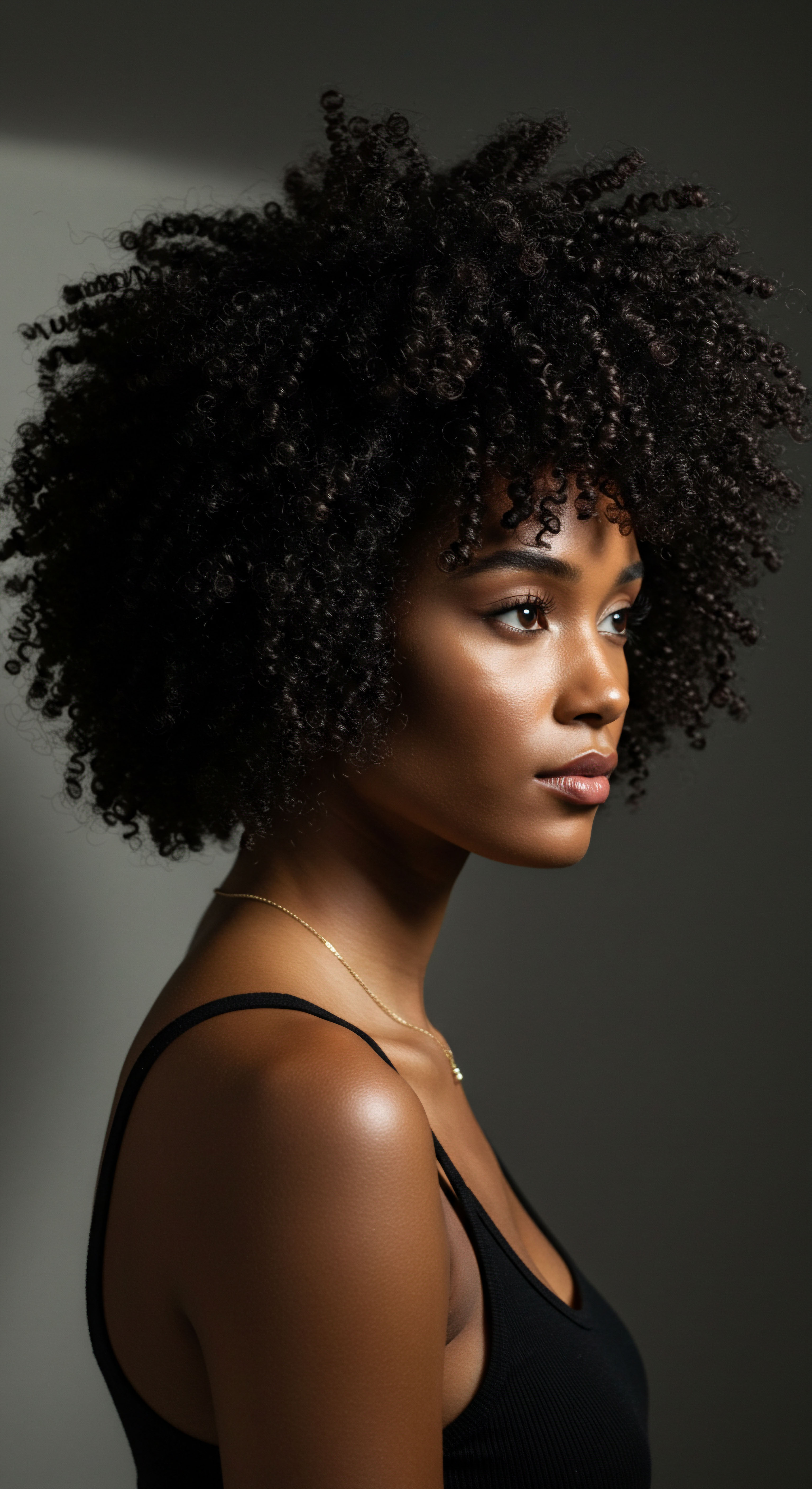
Intermediate
Moving beyond the fundamental definition, our understanding of static hair deepens, revealing its practical implications and its pervasive presence in the daily rhythms of textured hair care. Here, we consider the nuanced ways in which this electrostatic phenomenon intersects with styling choices, environmental factors, and the very products we choose to nurture our strands. It becomes a matter of discerning patterns, anticipating challenges, and cultivating intentional practices.

The Daily Dance ❉ Manifestations and Triggers
Static hair frequently makes its appearance in everyday scenarios, often surprising us with its sudden presence. It might be the moment a beloved scarf is removed, leaving a halo of hair standing at attention, or the subtle crackle felt when brushing through dry strands. The primary culprits behind these manifestations are often a combination of low humidity, friction from clothing or styling tools, and the hair’s own moisture content.
- Dry Air ❉ Winter months, characterized by cold, dry outdoor air and heated indoor environments, are notorious for creating conditions conducive to static buildup. The air acts as an insulator, allowing charges to linger.
- Friction ❉ The rubbing of hair against synthetic fabrics like polyester, nylon, or acrylic, commonly found in clothing, hats, and scarves, can readily generate static. Even certain hair brushes, particularly those with plastic bristles, can contribute to this charge transfer.
- Lack of Moisture ❉ Hair that is dehydrated lacks the internal water content necessary to conduct and dissipate electrical charges effectively. This makes it a prime candidate for static cling.

Product Formulations ❉ A Balancing Act
The cosmetic industry has long recognized the challenge of static hair, developing a range of products designed to mitigate its effects. Conditioners, leave-in treatments, and anti-static sprays often employ specific ingredients to address this issue. Cationic surfactants and polymers, which carry a positive charge, are frequently incorporated into these formulations. Hair, especially when cleansed with anionic (negatively charged) shampoos or when damaged, tends to have a net negative charge on its surface.
When positively charged ingredients are applied, they are attracted to the negatively charged areas of the hair, forming a thin, conductive layer that helps to neutralize the static charge and reduce friction between strands. This thoughtful interaction between product chemistry and hair’s electrical properties offers a tangible pathway to managing static.
| Ingredient Type Cationic Surfactants (e.g. Behentrimonium Chloride) |
| Mechanism of Action Positively charged molecules deposit on negatively charged hair, neutralizing static and smoothing the cuticle. |
| Benefit for Textured Hair Reduces frizz and flyaways, improves detangling, and adds slip, which is vital for textured hair. |
| Ingredient Type Cationic Polymers (e.g. Polyquaternium-10) |
| Mechanism of Action Form a thin, flexible film on the hair surface, providing conductivity and reducing friction. |
| Benefit for Textured Hair Offers long-lasting static control without heavy buildup, aiding in maintaining curl definition. |
| Ingredient Type Humectants (e.g. Glycerin, Hyaluronic Acid) |
| Mechanism of Action Attract and retain moisture from the air, increasing hair's conductivity and flexibility. |
| Benefit for Textured Hair Deeply hydrates often dry textured hair, making it less prone to static and more pliable. |
| Ingredient Type Natural Oils/Butters (e.g. Shea Butter, Jojoba Oil) |
| Mechanism of Action Coat the hair shaft, providing a protective barrier and reducing friction. |
| Benefit for Textured Hair Seals in moisture, adds weight and shine, and minimizes static-inducing friction, particularly beneficial for thicker textures. |
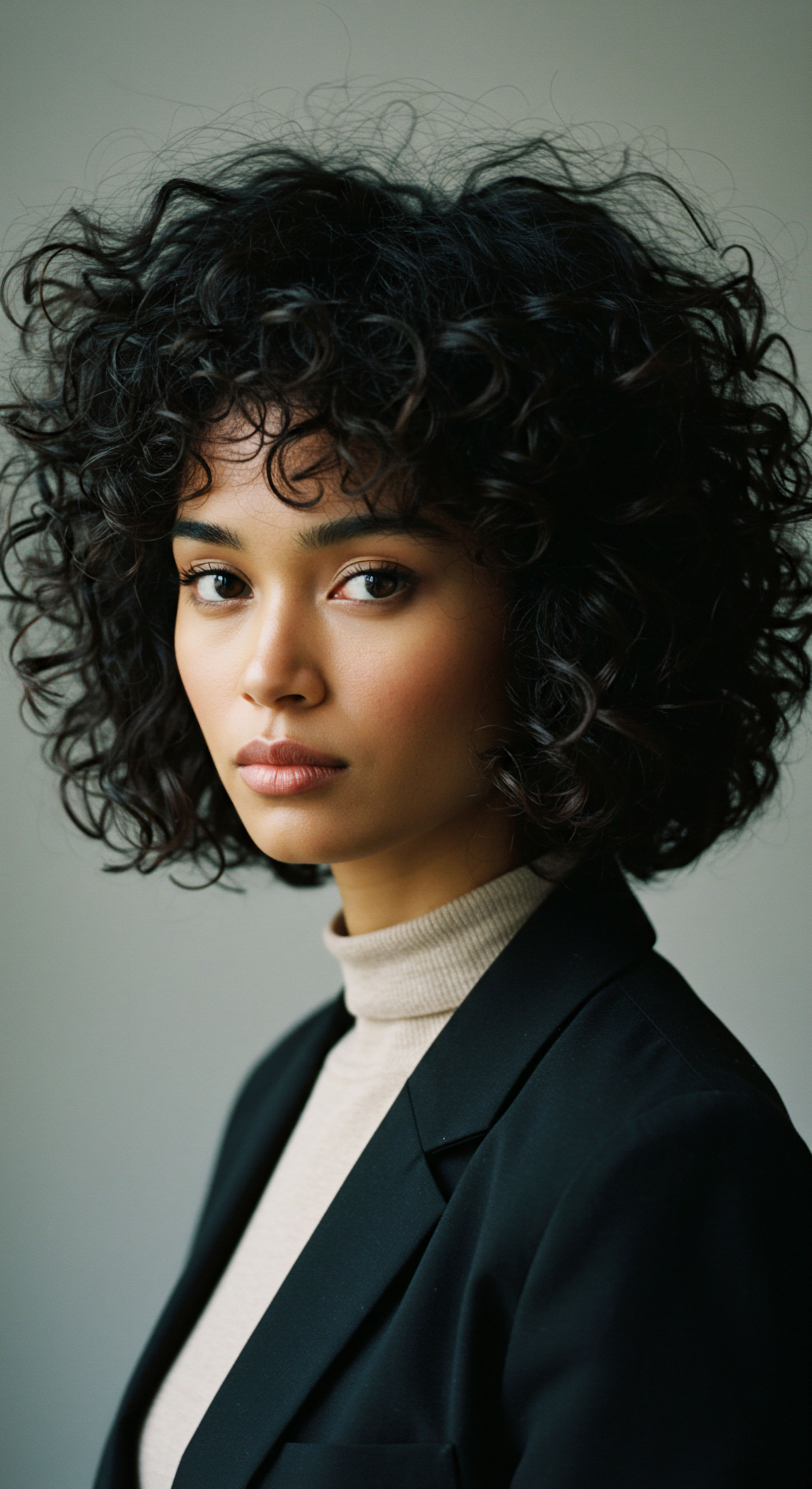
Environmental Influences ❉ Beyond the Obvious
While low humidity is a widely recognized trigger, the broader environmental context merits deeper consideration. Air quality, for instance, can indirectly impact static. Airborne dust particles, which can carry charges, might adhere more readily to statically charged hair. Furthermore, the very act of moving through dry air, even without direct contact with fabrics, can contribute to charge buildup as air molecules brush against hair fibers.
The construction materials of our living and working spaces also play a subtle role. Carpeting, especially synthetic varieties, can be a significant generator of static electricity. Walking across a carpet can charge the body, and this charge can then transfer to the hair upon contact. Understanding these less obvious environmental contributors allows for a more holistic approach to managing static.
The frequent appearance of static hair often signals a lack of moisture in the hair or environment, intensified by friction from materials like synthetic fabrics.

Practical Considerations for Textured Hair
For those tending to textured hair, the intermediate comprehension of static electricity translates into actionable care strategies. Given the propensity of coils and curls to experience dryness, consistent and generous moisture application becomes paramount. This means prioritizing hydrating shampoos, rich conditioners, and leave-in products. The selection of styling tools also gains importance; choosing combs and brushes made from natural materials like wood or bamboo, or those specifically designed to be anti-static (often infused with ionic properties), can significantly reduce charge generation.
Moreover, protective styling, a cornerstone of textured hair care, takes on an added layer of significance. Styles like braids, twists, and buns can minimize the direct exposure of hair strands to friction-generating elements, thereby reducing the likelihood of static buildup. The thoughtful integration of these practices into a hair care regimen moves beyond simply reacting to static, offering a proactive approach to maintaining serene, well-behaved strands.

Advanced
The exploration of static hair at an advanced echelon transcends simple observation, delving into the intricate physicochemical mechanisms, historical implications, and profound cultural dimensions that shape its meaning, particularly within the rich context of textured hair, Black hair, and mixed-race hair heritage. This is where the scientific rigor of a cosmetic chemist converges with the empathetic wisdom of a cultural historian, revealing a multifaceted understanding of this ubiquitous phenomenon. Here, the definition of static hair is not merely an explication of charge imbalance; it is a Delineation of its complex interplay with hair morphology, environmental chemistry, and societal narratives.

The Meaning of Static Hair ❉ A Delineation of Molecular Dance
At its core, the advanced meaning of static hair resides in the precise understanding of its triboelectric origin and the unique structural characteristics of hair fibers. Hair, as a biological polymer, is composed predominantly of keratin proteins, which possess a complex arrangement of amino acids. These amino acids contain various functional groups, including carboxylic acids and amines, whose ionization states are highly dependent on pH. The isoelectric point of human hair, typically around pH 3.67, indicates that at the normal slightly acidic pH of the hair surface (pH 4.5-5.5), the hair fiber carries a net negative charge.
When hair comes into contact with another material, especially those higher on the triboelectric series (such as certain synthetic polymers like acrylic or polyester), electrons are preferentially transferred from the hair to the other material, leaving the hair with an even greater net positive charge. Conversely, if the hair rubs against a material lower on the series, it might gain electrons, becoming negatively charged. The magnitude of this charge transfer is influenced by the materials’ positions on the triboelectric series, their surface properties (roughness, cuticle integrity), and critically, the ambient humidity.
The precise explanation of static hair involves understanding the dynamic interplay of these factors ❉ the hair’s inherent negative charge, its insulating properties in dry conditions, and the differential electron affinities of contacting materials. The resulting electrostatic repulsion between similarly charged hair strands, or attraction to oppositely charged surfaces, is the visible manifestation of this intricate molecular dance. This clarification underscores that static hair is not a flaw in the hair itself, but rather a predictable physical response to specific environmental and mechanical stimuli.
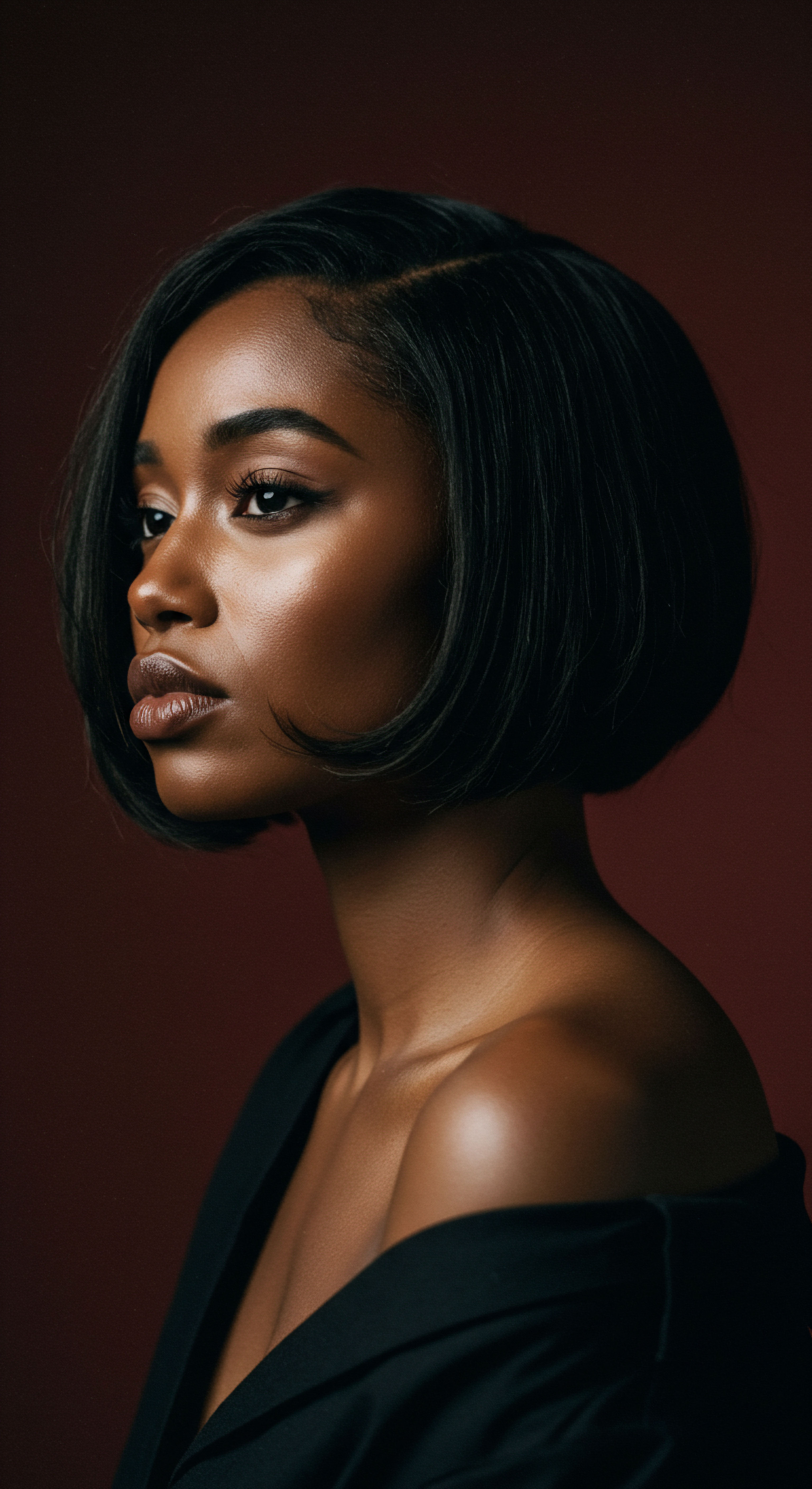
Morphological Nuances ❉ Textured Hair’s Unique Predisposition
The significance of static hair for textured hair types, including those of Black and mixed heritage, is amplified by their distinct morphological characteristics. Unlike straight hair, which typically has a round cross-section and tightly overlapping cuticles, textured hair often exhibits an elliptical or even flat cross-section, with a more irregular and sometimes more lifted cuticle layer.
This unique architecture contributes to several factors that heighten static susceptibility:
- Increased Surface Area and Friction ❉ The twists, turns, and sometimes more open cuticle scales of textured hair present a greater surface area for interaction with external materials. This increased contact can lead to more frequent and intense friction, thereby generating a higher magnitude of electrostatic charge.
- Moisture Retention Challenges ❉ The helical shape of textured hair makes it more difficult for natural sebum, produced by the scalp, to travel down the entire length of the hair shaft. This often results in drier hair, particularly at the ends. As previously established, dry hair is a less effective conductor of electricity, allowing static charges to accumulate and persist more readily.
- Mechanical Vulnerability ❉ The points of curvature in coiled and curly hair are inherently weaker due to stress concentrations. The physical forces associated with static repulsion, causing strands to stand apart and tangle, can increase mechanical stress on these vulnerable points, potentially leading to breakage if not managed with gentle care.
This understanding of the structural distinctions provides a compelling interpretation of why static hair can be a more persistent and challenging concern for individuals with textured hair, necessitating a specialized approach to care.
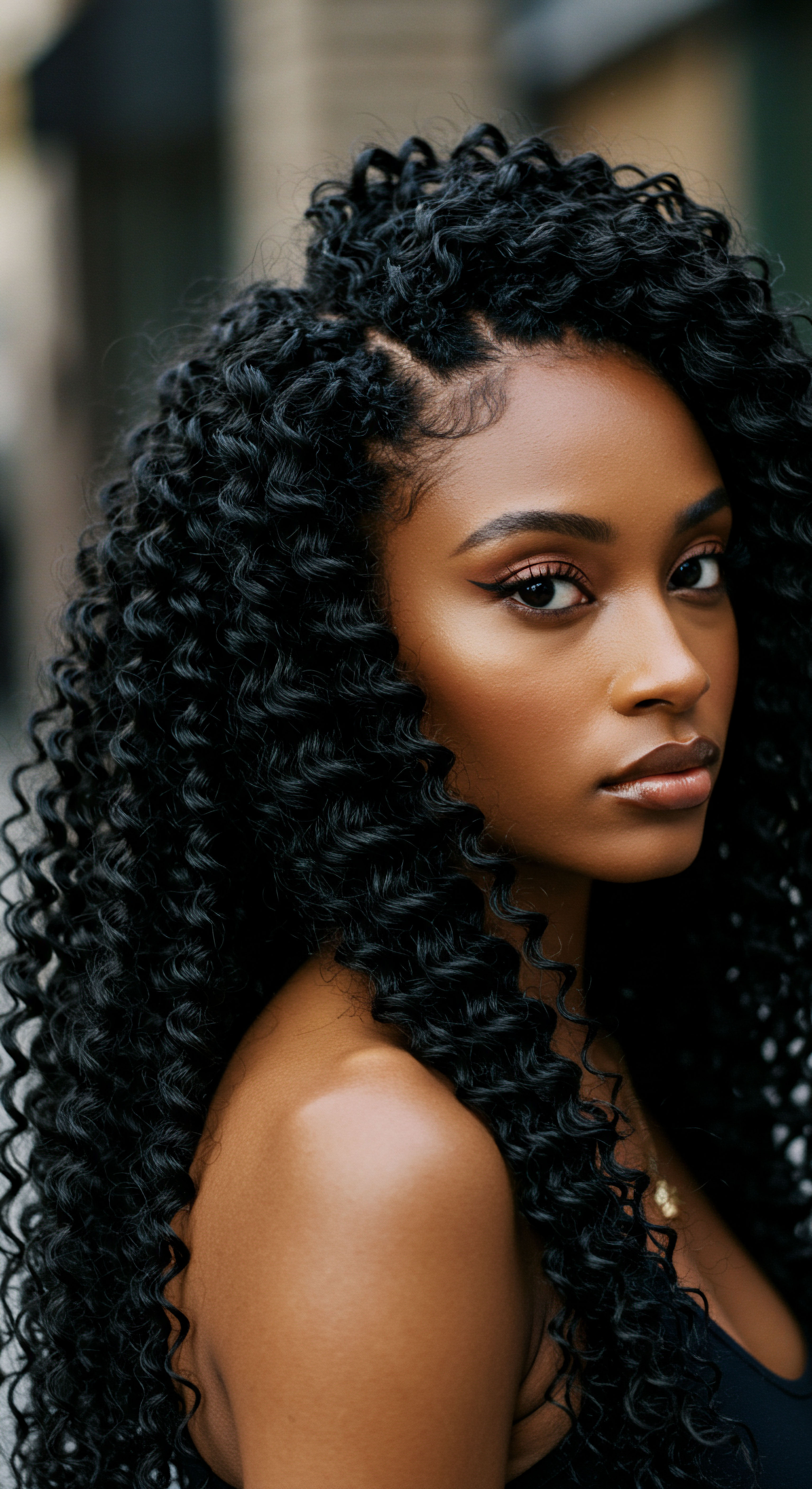
A Controversial Insight ❉ The Overlooked Environmental Burden of Hair Care in Black Communities and Its Static Implications
While discussions of static hair often center on personal discomfort or aesthetic disruption, a deeper, perhaps controversial, layer of its meaning for textured hair lies in the environmental and socio-economic contexts of hair care practices. The relentless pursuit of hair manageability, often exacerbated by issues like static, has historically driven significant consumption patterns within Black and mixed-race communities. Consider the environmental consequences of synthetic hair, frequently used in protective styles. These materials, often made from plastic polymers like kanekalon or toyokalon, contribute to microplastic pollution and take centuries to degrade in landfills.
A striking, though less commonly cited, observation is that Black women in the UK, despite comprising only 2% of the population, account for 10% of total haircare expenses. Globally, Black women spend approximately $1.1 billion on synthetic hair products. This disproportionate consumption, partly driven by the need for versatile styling and protection against environmental stressors that can exacerbate issues like static and dryness in natural hair, highlights a hidden environmental burden.
The materials chosen for protective styles, often synthetic, can themselves contribute to static charge generation due to their position on the triboelectric series and their interaction with natural hair. This creates a cyclical challenge ❉ the desire to protect delicate textured hair from environmental elements and manipulation, which might cause static, leads to the use of materials that, in turn, contribute to both static and a larger ecological footprint.
This reveals a complex interplay ❉ the very strategies employed to manage hair, including mitigating static, can inadvertently contribute to broader environmental challenges. The ethical framing here is not to place blame, but to acknowledge the systemic pressures and historical contexts that have shaped hair care practices within these communities, often compelling choices that carry unforeseen environmental costs. The conversation about static hair thus extends beyond the individual strand, touching upon environmental justice and sustainable beauty practices, urging a re-evaluation of product lifecycles and material choices.
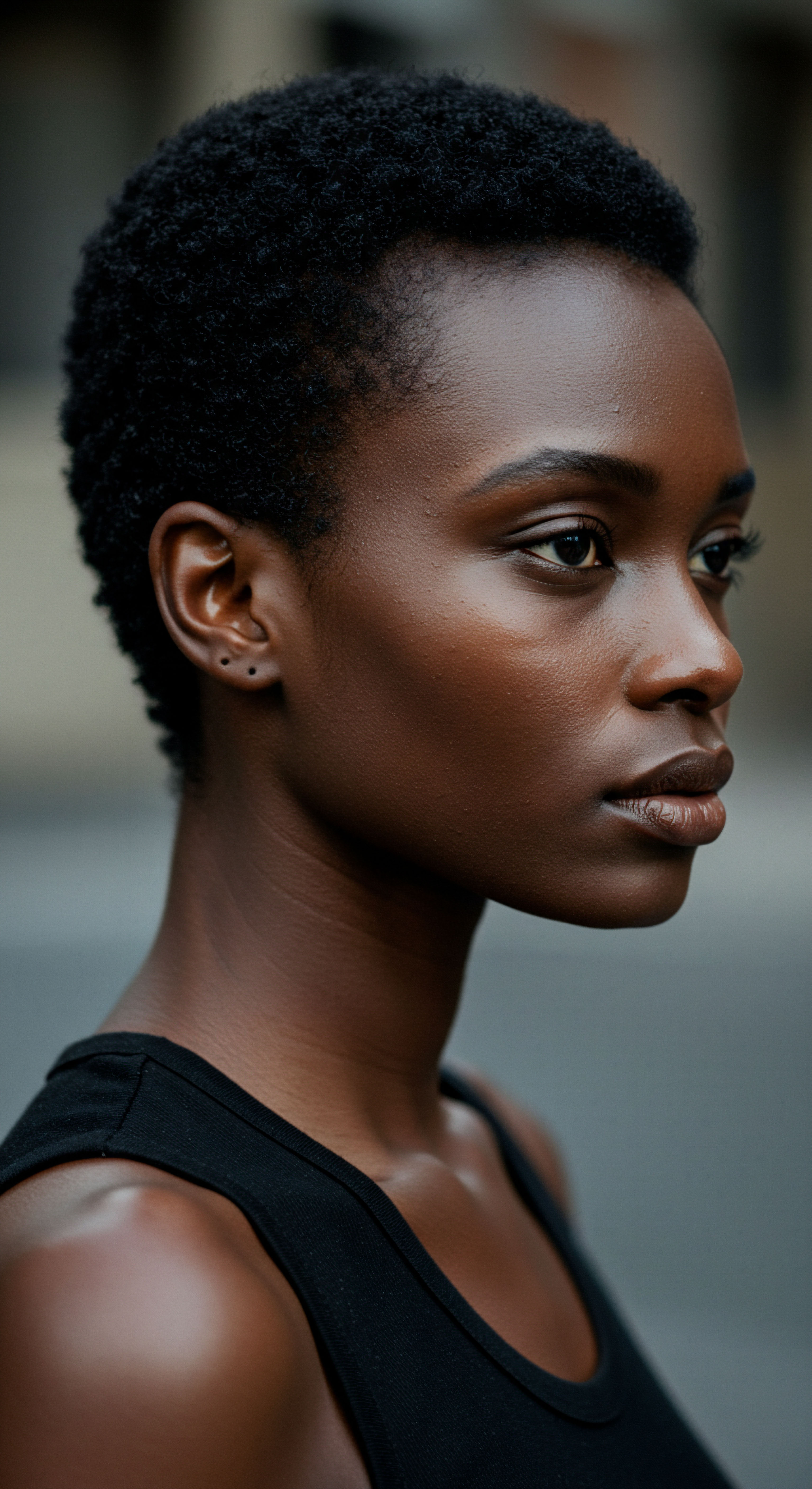
Cultural and Historical Contexts ❉ Hair as a Charged Canvas
The explication of static hair also benefits from a cultural and historical lens, particularly concerning Black hair. Hair, in many African and diasporic cultures, has always been more than mere adornment; it is a powerful symbol of identity, status, spirituality, and resistance.
- Protection and Preservation ❉ Traditional hair care practices, including intricate braiding and protective styles, were developed not only for aesthetic appeal but also to shield hair from environmental elements and minimize daily manipulation. This inherently reduced opportunities for static generation and damage.
- Material Choices and Heritage ❉ Historically, natural fibers like cotton and silk were often used for headwraps and bonnets. These materials, being closer to hair on the triboelectric series or possessing better moisture-retaining properties, are less likely to generate static compared to modern synthetic alternatives. The shift towards synthetic materials in contemporary hair accessories, while offering affordability and variety, introduces new challenges related to static.
- The Quest for Manageability ❉ Societal pressures and Eurocentric beauty standards have historically pushed textured hair towards straightened forms, often through chemical relaxers or excessive heat. These processes, by altering the hair’s protein structure and often leading to dryness and damage, can paradoxically increase its susceptibility to static and further perpetuate a cycle of intense product use.
Understanding static hair through this cultural lens means acknowledging the historical weight placed on hair’s appearance and manageability. The persistent presence of static, even in well-cared-for textured hair, can become a subtle reminder of environmental conditions and the need for culturally informed, sustainable care practices.

Advanced Methodologies and Future Insights
From an advanced scientific standpoint, research continues to refine our understanding of hair’s electrical properties. Techniques such as Electrokinetic Analysis and Atomic Force Microscopy are employed to study the surface charge density and friction coefficients of individual hair fibers under varying conditions. These methods provide granular data on how different cosmetic ingredients, environmental factors, and even the mechanical forces of combing impact charge generation and dissipation on a molecular level.
Future insights in managing static hair for textured types may lie in:
- Smart Materials ❉ Development of hair accessories and fabrics infused with conductive or self-neutralizing properties, perhaps drawing inspiration from natural materials that inherently resist static.
- Tailored Formulations ❉ Precision cosmetic chemistry creating anti-static products specifically calibrated for the unique surface chemistry and porosity of different textured hair patterns, moving beyond generic solutions.
- Bio-Inspired Solutions ❉ Investigating natural biological structures or traditional practices that effectively manage hair’s interaction with its environment, leading to novel, sustainable approaches.
The compound understanding of static hair, therefore, encompasses not only its physical basis but also its profound significance within the human experience, particularly for those whose hair carries a rich cultural legacy. It is a challenge that invites not just a superficial fix, but a deeper inquiry into the science, history, and sustainable future of hair care.
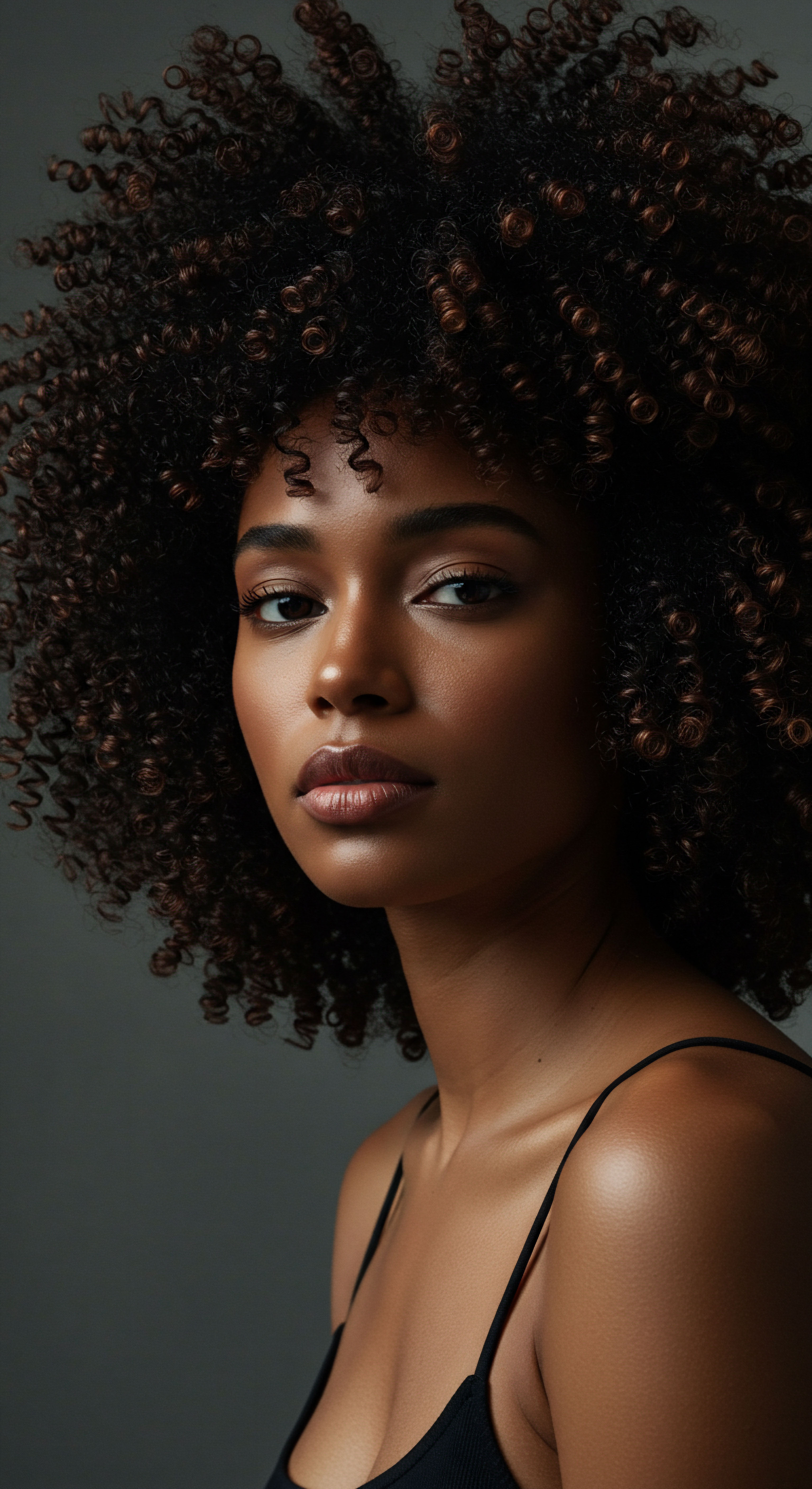
Reflection
The quiet hum of static hair, often perceived as a minor annoyance, unfolds into a profound narrative when viewed through the lens of Roothea’s holistic understanding. It is a whisper from our strands, a gentle reminder of the intricate balance between our inner landscape of moisture and the outer world’s atmospheric dance. For those with textured hair, this whisper often carries a particular resonance, speaking to a heritage of resilience and adaptation, urging us to listen more closely to our hair’s inherent wisdom.
This exploration has revealed that static is not merely a fleeting phenomenon, but a constant dialogue between the hair’s unique structure, the unseen currents of electron transfer, and the very air we breathe. It compels us to move beyond superficial solutions, inviting us into a deeper relationship with our hair, one grounded in scientific appreciation and cultural reverence. By embracing the complexity of static hair, we begin to appreciate the remarkable adaptability of our strands and the enduring power of informed, intentional care. It is a call to cherish the crown we wear, understanding its language, and honoring its journey.

References
- Johnson, Dale H. Hair and Hair Care. Marcel Dekker, 1997.
- Robbins, Charles R. Chemical and Physical Behavior of Human Hair. Springer, 2012.
- Zviak, Charles, and Robert L. Schueller. The Science of Hair Care. Marcel Dekker, 1986.
- McMullen, Roger L. et al. “Investigation of the interactions of cationic guar with human hair by electrokinetic analysis.” International Journal of Cosmetic Science, vol. 43, no. 4, 2021, pp. 375-390.
- Bhushan, R. J. “Friction and Wear of Human Hair.” Tribology Letters, vol. 35, no. 1, 2009, pp. 27-36.
- “Hair fiber characteristics and methods to evaluate hair physical and mechanical properties.” Brazilian Journal of Pharmaceutical Sciences, vol. 45, no. 1, 2009, pp. 103-111.
- Syed, A. N. et al. “Hair ❉ Its structure, chemical properties, and behavior.” Journal of Cosmetic Science, vol. 47, no. 6, 1996, pp. 291-304.
- “The Triboelectric Series Table.” Fraser Anti-Static Techniques, 2020.
- “The Triboelectric Series of Materials.” Electronics Teacher.
- “The Triboelectric Effect Series.” AlphaLab, Inc.